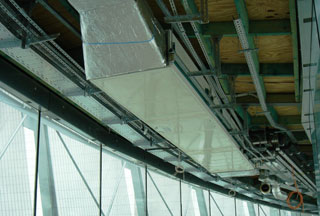"IoT Networking" entries

How to identify a scalable IoT network topology
Range, power consumption, scalability, and bandwidth dominate technology decisions.

HVAC Air Group in an airlift. Source: Hvac en kabelgoot
Three types of networking topologies are utilized in the Internet-of-Things: point-to-point, star, and mesh networking. To provide a way to explore the attributes and capabilities of each of these topologies, we defined a hypothetical (but realistic) application in the building monitoring and energy management space and methodically defined its networking requirements.
Let’s pull it all together to make a network selection for our building monitoring application. As described previously, the application will monitor, analyze, and optimize energy usage throughout the user’s properties. To accomplish this, monitoring and control points need to be deployed throughout each building, including occupancy and temperature sensors. Sensor data will be aggregated back to a central building automation panel located in each building. A continuous collection of data will provide a higher resolution of temperature and occupancy information, thus rendering better insight into HVAC performance and building utilization patterns. Comparison of energy utilization throughout the portfolio of properties allows lower performing buildings to be flagged.
Read more…

Mesh networking extends IoT reach
A suitable network topology for building automation.
 Editor’s note: this article is part of a series exploring the role of networking in the Internet of Things.
Editor’s note: this article is part of a series exploring the role of networking in the Internet of Things.
Today we are going to consider the attributes of wireless mesh networking, particularly in the context of our building monitoring and energy application.
A host of new mesh networking technologies came upon the scene in the mid-2000s through start-up ventures such as Millennial Net, Ember, Dust Networks, and others. The mesh network topology is ideally suited to provide broad area coverage for low-power, low-data rate applications found in application areas like industrial automation, home and commercial building automation, medical monitoring, and agriculture.

8 key attributes of Bluetooth networking
Bluetooth networking within the Internet of Things
This article is part of a series exploring the role of networking in the Internet of Things.
 Previously, we set out to choose the wireless technology standard that best fits the needs of our hypothetical building monitoring and energy application. Going forward, we will look at candidate technologies within all three networking topologies discussed earlier: point-to-point, star, and mesh. We’ll start with Bluetooth, the focus of this post.
Previously, we set out to choose the wireless technology standard that best fits the needs of our hypothetical building monitoring and energy application. Going forward, we will look at candidate technologies within all three networking topologies discussed earlier: point-to-point, star, and mesh. We’ll start with Bluetooth, the focus of this post.
Bluetooth is the most common wireless point-to-point networking standard, designed for exchanging data over short distances. It was developed to replace the cables connecting portable and/or fixed devices.
Today, Bluetooth is well suited for relatively simple applications where two devices need to connect with minimal configuration setup, like a button press, as in a cell phone headset. The technology is used to transfer information between two devices that are near each other in low-bandwidth situations such as with tablets, media players, robotics systems, handheld and console gaming equipment, and some high-definition headsets, modems, and watches.
When considering Bluetooth for use in our building application, we must consider the capabilities of the technology and compare these capabilities to the nine application attributes outlined in my previous post. Let’s take a closer look at Bluetooth across these eight key attributes.

9 things to consider before deploying sensors
Defining application requirements for IoT networking standards.
This article is part of a series exploring the role of networking in the Internet of Things.
Each networking technology has very different attributes and capabilities. When evaluating protocols and standards for your IoT project, you’ll need to understand all of the technical and financial requirements underlying your application in order to effectively choose a technology to implement. Let’s take a look at the typical networking requirements in designing solutions for the Internet of Things.
To provide a concrete illustration of the requirements analysis, I will describe a hypothetical building energy management application and outline a comprehensive list of its wireless network requirements. This list of requirements will form a framework for future discussion of the networking technology standards currently on the market.

3 topologies driving IoT networking standards
The importance of network architecture on the Internet of Things
This article is part of a series exploring the role of networking in the Internet of Things.
There are a lot of moving parts in the networking for the Internet of Things; a lot to sort out between WiFi, WiFi LP, Bluetooth, Bluetooth LE, Zigbee, Z-Wave, EnOcean and others. Some standards are governed by open, independent standards bodies, while others are developed by a single company and are being positioned as defacto standards. Some are well established, others are in the early adoption stage. All were initially developed to meet unique application-specific requirements such as range, power consumption, bandwidth, and scalability. Although these are familiar issues, they take on a new urgency in IoT networks.
To begin establishing the right networking technology for your application, it is important to first understand the network architecture, or the network topology, that is supported by each technology standard. The networking standards being used today in IoT can be categorized into three basic network topologies; point-to-point, star, and mesh. Read more…